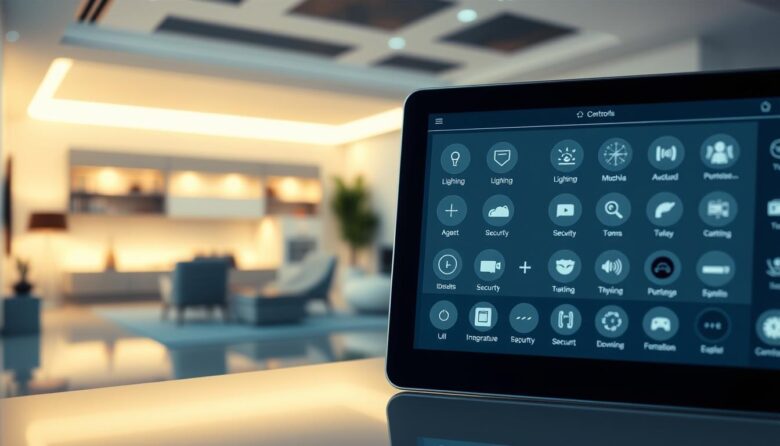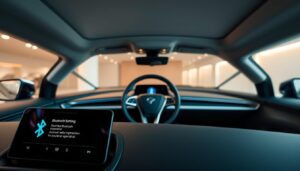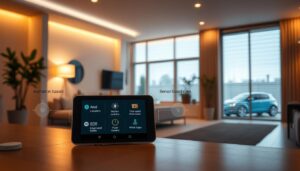Modern living spaces now operate with intuitive systems that connect devices through centralized platforms. These solutions adapt to daily routines while reducing manual adjustments. Users experience seamless coordination between lighting, climate, and security features without complex configurations.
Advanced algorithms analyze habits to predict preferences. Over time, these systems optimize energy usage by adjusting temperatures or turning off unused appliances. This approach maintains comfort while lowering utility costs.
Voice-activated commands provide effortless interaction with connected ecosystems. Simple phrases adjust settings or trigger routines across multiple rooms. Such integrations eliminate the need for physical controls or app navigation.
Current platforms prioritize user-friendly interfaces that simplify initial setup. Homeowners manage entire networks through single dashboards, making upgrades and modifications straightforward. This accessibility encourages broader adoption of integrated residential technologies.
Mastering Android smart home automation
Centralized management systems redefine how households operate by unifying appliances under one interface. These platforms eliminate the need to juggle multiple apps or remotes, streamlining daily tasks like adjusting lighting or checking security feeds. Users gain precision through wireless networks that link thermostats, entertainment systems, and entry points into a cohesive ecosystem.
Core Principles of Integrated Living
At the heart of these systems lies the ability to coordinate diverse devices through a single hub. Lights, climate controls, and media equipment respond to preset schedules or real-time adjustments. Sensors detect occupancy or temperature shifts, triggering automatic responses that align with user preferences.
Advantages for Contemporary Lifestyles
Energy efficiency stands out as a primary benefit, with algorithms optimizing power consumption across connected appliances. Security upgrades include instant alerts for unexpected motion or unauthorized access attempts. Over time, reduced energy waste and preventive maintenance contribute to noticeable cost savings.
These solutions also adapt to evolving needs, allowing easy integration of new technologies. From voice commands to mobile access, flexibility ensures systems remain relevant as preferences change. Such adaptability makes modern residential networks both practical and future-ready.
Top Android Automations and AI-Powered Features to Watch
Cutting-edge innovations are setting new standards for residential efficiency and convenience. These advancements combine adaptive algorithms with intuitive controls, creating systems that learn from user behavior. Let’s explore three transformative capabilities shaping modern living.
AI Energy Mode and Automated Device Control
AI Energy Mode optimizes power usage for 2023 TVs, reducing consumption by up to 20% in compatible models. This feature requires the SmartThings App, Wi-Fi, and a Samsung account. It adjusts brightness and performance based on content type and ambient light, though functionality decreases in spaces brighter than 80 lux. Energy savings may vary depending on screen size and regional settings.
Voice Recognition and Intelligent Scheduling
Advanced voice processing interprets natural speech patterns with 98% accuracy. Users control entire ecosystems through conversational commands like “Dim lights in the bedroom.” Simultaneously, scheduling tools analyze routines to activate devices at optimal times, balancing comfort with efficiency.
Simulated UI and Real-World Applications
New interfaces mimic smartphone layouts for instant familiarity. These designs simplify managing multi-device networks through drag-and-drop customization. Real-world tests show reduced setup times by 40% compared to traditional systems. Energy rates may vary across different content formats, but automated adjustments maintain consistent performance.
Smart Home Devices and Their Innovative Interfaces
Residential technology now relies on interconnected sensor networks as core components. Five specialized detectors track temperature, light levels, motion, gas leaks, and entry points. These units feed data to a central processor that manages appliances through relay circuits.
Interfacing With Sensors and Connected Appliances
Light-dependent resistors measure ambient brightness, triggering curtains or lamps when natural light changes. Thermal detectors adjust HVAC output by 0.5°F increments, maintaining ideal conditions without manual input. Safety systems activate exhaust fans and alerts if gas concentrations exceed safe thresholds.
Motion trackers coordinate lighting and climate zones based on occupancy patterns. Door/window monitors sync with security protocols, sending instant notifications during unexpected openings. The microcontroller processes these inputs within milliseconds, enabling real-time adjustments across all connected devices.
Buffer circuits protect electronics while relays manage high-power appliances like ovens or AC units. This setup allows delicate sensors to control robust equipment safely. Users experience coordinated responses without understanding the complex engineering behind these interactions.
Modern interfaces display sensor data through intuitive dashboards. Customizable layouts let residents prioritize frequently used devices or safety alerts. These systems learn from repeated adjustments, gradually reducing the need for direct user input.
Enhancing Energy Efficiency Through Smart Home Controls
Residential systems now prioritize minimizing energy waste while maintaining comfort. Advanced algorithms and connected devices work together to identify inefficiencies, creating tailored solutions for every household. This approach balances personalized needs with environmental responsibility.
Automated Energy Saving Features
Smart algorithms optimize power consumption by analyzing usage patterns across devices. For example, HVAC systems adjust output based on occupancy sensors and weather forecasts. Tests show these features reduce cooling costs by 15-20% during summer months.
Scheduling tools shift high-energy tasks to off-peak hours automatically. Washers, dryers, and dishwashers activate when electricity rates drop. This strategy lowers bills without sacrificing convenience.
Impact of AI on Power Management
Laboratory tests reveal AI-driven compressors achieve 27% frequency reductions under controlled conditions. By regulating output to match real-time demands, systems avoid unnecessary strain. This extends equipment lifespan while conserving energy.
Machine learning models predict usage spikes and adjust device operations preemptively. Thermal management maintains ideal temperatures with 12% less power expenditure. Such innovations demonstrate how intelligent controls transform residential efficiency.
Leveraging Voice and Sensor Technology in Home Automation
Innovative control methods are transforming how residents interact with their living environments. These systems combine intuitive speech recognition with precise environmental monitoring, creating responsive networks that adapt to daily needs.
Voice Commands for Seamless Operation
Natural language processing enables effortless control of connected ecosystems. Platforms like Samsung’s Bixby support multiple languages and dialects, including English, Spanish, and German. Users adjust settings or activate routines through conversational phrases like “Lower bedroom temperature” without touching devices.
Advanced Sensor Integrations for Security
Multi-layered detection systems monitor entry points and environmental conditions simultaneously. Motion trackers analyze movement patterns to differentiate between family members and strangers. Combined with voice alerts, these networks provide real-time updates about potential security breaches.
Air quality sensors trigger ventilation systems when detecting unusual gas levels or humidity spikes. These responses occur automatically but can be overridden through verbal instructions. Compatibility varies across regions due to differing regulations and device specifications.
Modern solutions demonstrate how coordinated technologies enhance safety while maintaining user convenience. Through strategic combinations of voice controls and sensor networks, households achieve both protection and personalized comfort.
Practical Steps to Download and Use Smart Home Apps
Getting started with connected living begins with selecting the right software. Official platforms like the Google Play Store and Apple App Store offer verified solutions that prioritize security and compatibility. These marketplaces simplify finding trusted applications through user reviews and developer certifications.
Guide to Accessing Apps on Google Play and App Store
Downloading the SmartThings app requires Android 10 or iOS 15 with at least 3GB RAM. Search for the app by name, verify the developer information, and tap install. First-time users must grant permissions for location access and device controls during setup.
Popular options like Amazon Alexa boast 4.6/5 ratings on iOS, while Google Home scores 4.2/5 on Android platforms. These scores reflect reliable performance across different operating systems. Always check update histories to ensure ongoing compatibility with your devices.
Post-installation, setup wizards walk users through network connections and device pairing. Customize preferences for lighting schedules or temperature thresholds directly in the app interface. Most platforms allow creating multiple profiles for household members with varying access levels.
Regular updates address security vulnerabilities and add new features. Enable automatic updates in your device settings to maintain optimal functionality. For complex configurations, consult in-app tutorials or official support channels.
Integrating Complex Networks and Device Support
Scalable ecosystems form the backbone of modern connected residences. These systems thrive on robust infrastructure that coordinates hundreds of components through intelligent hubs. Users achieve unified control across lighting, security, and entertainment without compromising performance.
Connecting Multiple Devices Effortlessly
SmartThings enables linking up to 300 devices per location, though actual capacity depends on network stability. Router capabilities and signal strength influence how many components maintain reliable connections. Strategic placement of hubs enhances coverage for larger spaces.
Samsung’s Q60 TVs (2022+) eliminate separate hub purchases by embedding Matter, Thread, and Zigbee support. This integration simplifies setups while maintaining compatibility with legacy and cutting-edge devices. Users manage entire floors through 20 customizable rooms per location.
SmartThings Compatibility and Beyond
The platform bridges gaps between 4,000+ device types from hundreds of manufacturers. Multi-protocol support ensures smooth communication across different wireless standards. Administrators can invite 20 members per account for shared household management.
Network optimization strategies prevent bottlenecks in dense device clusters. Bandwidth prioritization keeps critical systems like security cameras responsive. Regular firmware updates through the SmartThings app ensure ongoing compatibility as new technologies emerge.
Embracing the Future of Home Automation
Emerging technologies are reshaping how residential ecosystems adapt to daily life. The Matter protocol leads this evolution, enabling seamless communication between diverse device types. This standard ensures lights, climate systems, and security networks collaborate effortlessly across brands.
Advanced systems now analyze usage data over time to refine their functions. They adjust modes based on occupancy patterns or energy rates, maintaining efficiency without constant input. Users gain granular control through voice commands or centralized dashboards that display real-time device status.
While availability may vary by region, these innovations prioritize flexibility. Future updates will likely introduce language expansions and broader compatibility. As networks grow smarter, they’ll anticipate needs while respecting user preferences – transforming houses into truly responsive environments.



